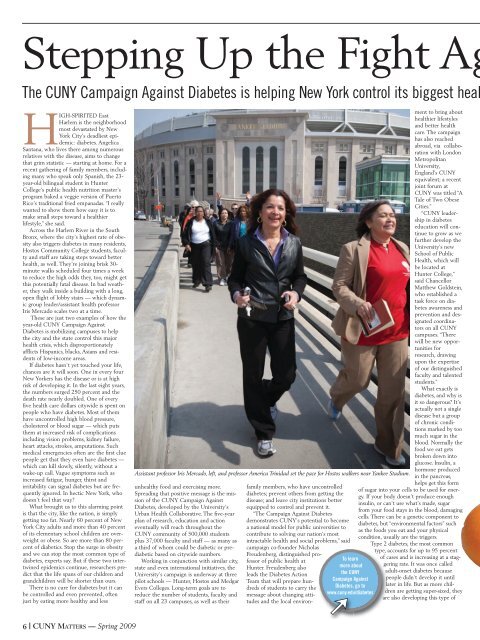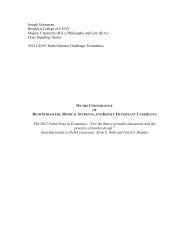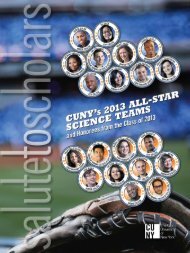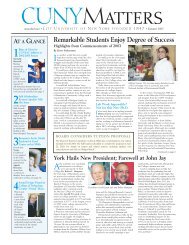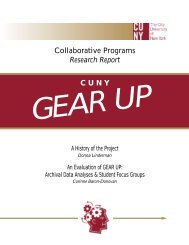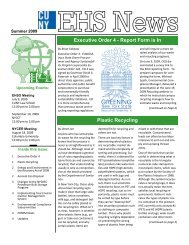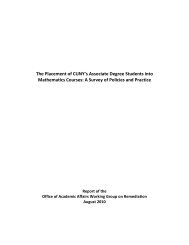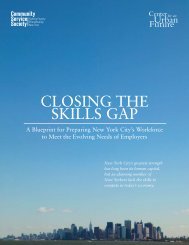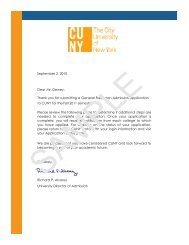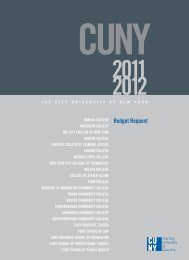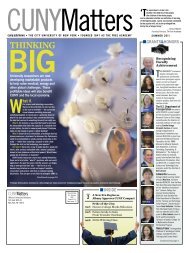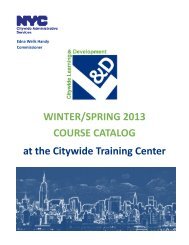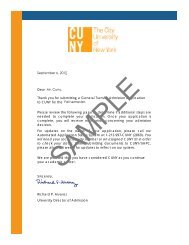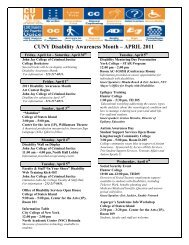Spring 2009 5 pages final correx - CUNY
Spring 2009 5 pages final correx - CUNY
Spring 2009 5 pages final correx - CUNY
You also want an ePaper? Increase the reach of your titles
YUMPU automatically turns print PDFs into web optimized ePapers that Google loves.
Stepping Up the Fight Ag<br />
The <strong>CUNY</strong> Campaign Against Diabetes is helping New York control its biggest heal<br />
HIGH-SPIRITED East<br />
Harlem is the neighborhood<br />
most devastated by New<br />
York City’s deadliest epidemic:<br />
diabetes. Angelica<br />
Santana, who lives there among numerous<br />
relatives with the disease, aims to change<br />
that grim statistic — starting at home. For a<br />
recent gathering of family members, including<br />
many who speak only Spanish, the 23-<br />
year-old bilingual student in Hunter<br />
College’s public health nutrition master’s<br />
program baked a veggie version of Puerto<br />
Rico’s traditional fried empanadas. “I really<br />
wanted to show them how easy it is to<br />
make small steps toward a healthier<br />
lifestyle,” she said.<br />
Across the Harlem River in the South<br />
Bronx, where the city’s highest rate of obesity<br />
also triggers diabetes in many residents,<br />
Hostos Community College students, faculty<br />
and staff are taking steps toward better<br />
health, as well. They’re joining brisk 30-<br />
minute walks scheduled four times a week<br />
to reduce the high odds they, too, might get<br />
this potentially fatal disease. In bad weather,<br />
they walk inside a building with a long,<br />
open flight of lobby stairs — which dynamic<br />
group leader/assistant health professor<br />
Iris Mercado scales two at a time.<br />
These are just two examples of how the<br />
year-old <strong>CUNY</strong> Campaign Against<br />
Diabetes is mobilizing campuses to help<br />
the city and the state control this major<br />
health crisis, which disproportionately<br />
afflicts Hispanics, blacks, Asians and residents<br />
of low-income areas.<br />
If diabetes hasn’t yet touched your life,<br />
chances are it will soon. One in every four<br />
New Yorkers has the disease or is at high<br />
risk of developing it. In the last eight years,<br />
the numbers surged 250 percent and the<br />
death rate nearly doubled. One of every<br />
five health care dollars citywide is spent on<br />
people who have diabetes. Most of them<br />
have uncontrolled high blood pressure,<br />
cholesterol or blood sugar — which puts<br />
them at increased risk of complications<br />
including vision problems, kidney failure,<br />
heart attacks, strokes, amputations. Such<br />
medical emergencies often are the first clue<br />
people get that they even have diabetes —<br />
which can kill slowly, silently, without a<br />
wake-up call. Vague symptoms such as<br />
increased fatigue, hunger, thirst and<br />
irritability can signal diabetes but are frequently<br />
ignored. In hectic New York, who<br />
doesn’t feel that way<br />
What brought us to this alarming point<br />
is that the city, like the nation, is simply<br />
getting too fat. Nearly 60 percent of New<br />
York City adults and more than 40 percent<br />
of its elementary school children are overweight<br />
or obese. So are more than 80 percent<br />
of diabetics. Stop the surge in obesity<br />
and we can stop the most common type of<br />
diabetes, experts say. But if these two intertwined<br />
epidemics continue, researchers predict<br />
that the life spans of our children and<br />
grandchildren will be shorter than ours.<br />
There is no cure for diabetes but it can<br />
be controlled and even prevented, often<br />
just by eating more healthy and less<br />
Assistant professor Iris Mercado, left, and professor America Trinidad set the pace for Hostos walkers near Yankee Stadium.<br />
unhealthy food and exercising more.<br />
Spreading that positive message is the mission<br />
of the <strong>CUNY</strong> Campaign Against<br />
Diabetes, developed by the University’s<br />
Urban Health Collaborative. The five-year<br />
plan of research, education and action<br />
eventually will reach throughout the<br />
<strong>CUNY</strong> community of 500,000 students<br />
plus 37,000 faculty and staff — as many as<br />
a third of whom could be diabetic or prediabetic<br />
based on citywide numbers.<br />
Working in conjunction with similar city,<br />
state and even international initiatives, the<br />
University’s campaign is underway at three<br />
pilot schools — Hunter, Hostos and Medgar<br />
Evers Colleges. Long-term goals are to<br />
reduce the number of students, faculty and<br />
staff on all 23 campuses, as well as their<br />
family members, who have uncontrolled<br />
diabetes; prevent others from getting the<br />
disease; and leave city institutions better<br />
equipped to control and prevent it.<br />
“The Campaign Against Diabetes<br />
demonstrates <strong>CUNY</strong>’s potential to become<br />
a national model for public universities to<br />
contribute to solving our nation’s most<br />
intractable health and social problems,” said<br />
campaign co-founder Nicholas<br />
To learn<br />
more about<br />
the <strong>CUNY</strong><br />
Campaign Against<br />
Diabetes, go to<br />
www.cuny.edu/diabetes<br />
Freudenberg, distinguished professor<br />
of public health at<br />
Hunter. Freudenberg also<br />
leads the Diabetes Action<br />
Team that will prepare hundreds<br />
of students to carry the<br />
message about changing attitudes<br />
and the local environment<br />
to bring about<br />
healthier lifestyles<br />
and better health<br />
care. The campaign<br />
has also reached<br />
abroad, via collaboration<br />
with London<br />
Metropolitan<br />
University,<br />
England’s <strong>CUNY</strong><br />
equivalent; a recent<br />
joint forum at<br />
<strong>CUNY</strong> was titled “A<br />
Tale of Two Obese<br />
Cities.”<br />
“<strong>CUNY</strong> leadership<br />
in diabetes<br />
education will continue<br />
to grow as we<br />
further develop the<br />
University’s new<br />
School of Public<br />
Health, which will<br />
be located at<br />
Hunter College,”<br />
said Chancellor<br />
Matthew Goldstein,<br />
who established a<br />
task force on diabetes<br />
awareness and<br />
prevention and designated<br />
coordinators<br />
on all <strong>CUNY</strong><br />
campuses. “There<br />
will be new opportunities<br />
for<br />
research, drawing<br />
upon the expertise<br />
of our distinguished<br />
faculty and talented<br />
students.”<br />
What exactly is<br />
diabetes, and why is<br />
it so dangerous It’s<br />
actually not a single<br />
disease but a group<br />
of chronic conditions<br />
marked by too<br />
much sugar in the<br />
blood. Normally the<br />
food we eat gets<br />
broken down into<br />
glucose. Insulin, a<br />
hormone produced<br />
in the pancreas,<br />
helps get this form<br />
of sugar into your cells to be used for energy.<br />
If your body doesn’t produce enough<br />
insulin, or can’t use what’s made, sugar<br />
from your food stays in the blood, damaging<br />
cells. There can be a genetic component to<br />
diabetes, but “environmental factors” such<br />
as the foods you eat and your physical<br />
condition, usually are the triggers.<br />
Type 2 diabetes, the most common<br />
type, accounts for up to 95 percent<br />
of cases and is increasing at a staggering<br />
rate. It was once called<br />
adult-onset diabetes because<br />
people didn’t develop it until<br />
later in life. But as more children<br />
are getting super-sized, they<br />
are also developing this type of<br />
6 <strong>CUNY</strong> MATTERS — <strong>Spring</strong> <strong>2009</strong>


